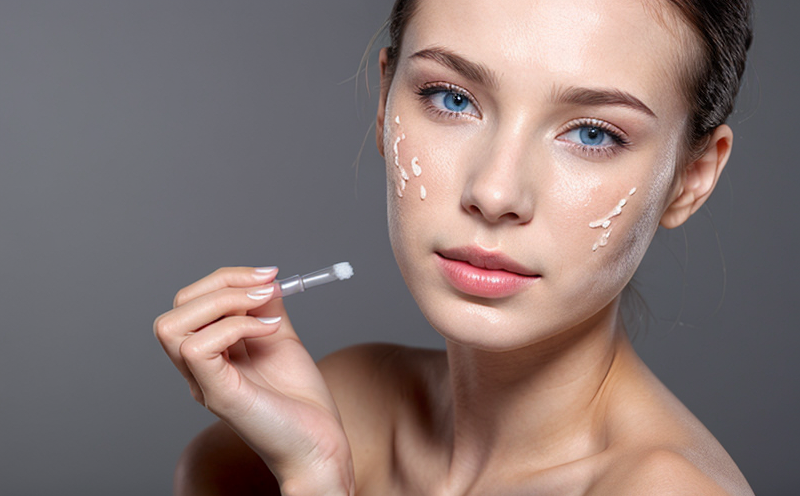Irritation Testing of Cosmetic Exfoliating Acids
The irritation testing of cosmetic exfoliating acids is a critical step in ensuring that products meet safety standards and do not cause adverse reactions on the skin. This service addresses the potential for skin irritation caused by acids commonly used in exfoliants such as alpha-hydroxy acids (AHAs), beta-hydroxy acids (BHAs), and polyhydroxy acids (PHAs). The primary objective is to identify the safety profile of these ingredients and ensure that they are suitable for use in cosmetic products.
The testing process involves several stages, each designed to assess different aspects of skin irritation. Specimens are prepared by applying a standardized concentration of the exfoliating acid solution onto the skin of test subjects or using in vitro models. The specimens are then observed over time for signs of irritation such as redness, swelling, and itching.
Industry standards such as ISO 10735:2018 and ASTM F801 provide guidelines on how to conduct these tests accurately and reliably. These standards ensure that the testing process is consistent across different laboratories worldwide. Compliance with these standards is crucial for manufacturers who wish to market their products globally.
The importance of this test cannot be overstated, especially given the increasing consumer demand for natural and effective skincare solutions. Exfoliating acids are popular due to their ability to improve skin texture and tone; however, they must be used safely. This testing service helps ensure that the products meet both regulatory requirements and consumer expectations.
In addition to assessing irritation potential, this test also provides valuable insights into the efficacy of exfoliating agents. By understanding how these acids interact with various skin types, manufacturers can refine their formulations to enhance performance while maintaining safety.
- Alpha-hydroxy acids (AHAs): Commonly used in cosmetic products for their ability to dissolve dead skin cells and improve hydration levels.
- Polyhydroxy acids (PHAs): Known for their gentler nature compared to AHAs, making them suitable for sensitive skins.
The testing process is rigorous and involves multiple steps to ensure accuracy. Specimens are prepared in a controlled environment under strict conditions to mimic real-world usage scenarios as closely as possible. This ensures that the results obtained from this test are representative of actual consumer experiences.
Once tested, detailed reports are generated summarizing all findings. These reports include information on any signs of irritation observed during testing, along with recommendations for further refinement if necessary. Such reports play a key role in guiding product development and ensuring compliance with relevant regulations.
By investing in this service, cosmetic companies can demonstrate their commitment to producing safe and effective skincare products that meet both regulatory requirements and consumer needs. This proactive approach not only enhances brand reputation but also fosters trust among consumers who value transparency and quality assurance.
- In vivo testing: Where live subjects are used to observe skin reactions directly after applying the exfoliating acids.
- In vitro models: Utilizing cell cultures or other non-living systems to simulate skin conditions more cost-effectively than in vivo methods.
The results from these tests contribute significantly towards understanding the behavior of different types of exfoliating acids under various conditions. This knowledge is invaluable not only for current product development but also for future innovations within the industry.
Overall, irritation testing of cosmetic exfoliating acids serves as a vital component in maintaining high standards of safety and efficacy in the cosmetics sector. It ensures that consumers can enjoy the benefits offered by these products without risking their health or well-being.
Industry Applications
- Formulating safe and effective exfoliating creams, lotions, and serums.
- Evaluating new ingredients before incorporating them into existing formulas.
- Determining appropriate concentrations of acids for optimal results without causing harm.
The data generated from irritation testing can be leveraged across various stages of product development. From initial concept phases to final production runs, this information helps guide decisions that ultimately lead to better performing and safer products.
Why Choose This Test
- Compliance with international standards ensures consistency and reliability of results.
- Promotes safer formulations by identifying potential irritants early in the development process.
- Enhances brand reputation through demonstrated commitment to product safety and quality.
Choosing this service means accessing expert knowledge and state-of-the-art facilities dedicated solely to ensuring the highest level of accuracy and precision. With our team of experienced professionals, you can rest assured that your products will undergo thorough evaluation before reaching market shelves.
International Acceptance and Recognition
The testing procedures adhered to international standards such as ISO 10735:2018 and ASTM F801 are widely recognized globally. These guidelines provide a framework for conducting consistent, reliable tests which can be trusted by regulatory bodies worldwide.
By adopting these internationally accepted practices, cosmetic brands demonstrate their adherence to global best practices in product safety and quality assurance. This recognition enhances credibility among consumers and strengthens market competitiveness.





